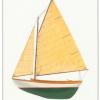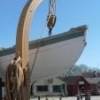-
Posts
1,145 -
Joined
-
Last visited
Reputation Activity
-
 Keith_W reacted to Jack Panzeca in Oseberg Viking Ship by Jack P - FINISHED - Billing Boats - 1/25 Scale - 9th Century - (Modified)
Keith_W reacted to Jack Panzeca in Oseberg Viking Ship by Jack P - FINISHED - Billing Boats - 1/25 Scale - 9th Century - (Modified)
Time for another update.
The kit makes no mention of the iron nails that hold the overlapping planks together. I felt that the ship would really be incomplete without them so I decided to spend a few weeks and do it.
The nails are about 200 mm apart on the Oseberg but do show some randomness. That scales out to 8 mm. I did a couple of test planks 1 at 8 mm and 1 at 16 mm. I was hoping that the 16 mm spacing would look great and save me about 700 nails. Oh well, no luck. I did widen the spacing to 10 mm.
I bought the smallest brass nails that I could find and blackened them using the method sited in various places on MSW but I specifically read it in Augie"s Confederacy log (great log by the way!). I marked the holes with dividers and patiently drilled the 720, ½ mm holes. It took over a week to mark and drill and insert all those nails. I broke several bits in the process. I forgot to mention that this is only the port side.
I will place a drop of CA at the base of the nail forest and cut them off before I glue the deck in place.
I decided to go ahead and stain after the holes were drilled and before the nails were inserted. I spent some time cleaning up the glue that was left where the planks overlapped so the stain would go on evenly. I had cleaned up carefully when the planks were glued but the best laid plans...
I still have some touch up to do on the stain and I will add the wipe on poly at the very end. I have taken a couple of days off to decompress after the first half and it is back to work tomorrow.
-
 Keith_W got a reaction from pete48 in Stars & Stripes (US-55 ) 1987 by pete48 - Scale 3/16" = 1'
Keith_W got a reaction from pete48 in Stars & Stripes (US-55 ) 1987 by pete48 - Scale 3/16" = 1'
Pete I somehow missed the start of this one, but no matter ... i'm here now and glued to the screen!
I was in Fremantle in 1987, only a few years before I migrated to Australia. So no prizes for guessing who I was rooting for. Unfortunately, Australia IV didn't get very far and Kookaburra III was soundly trounced by S&S. Fremantle was transformed by the Americas Cup - before 1987, the town was pretty grungy and more or less a hangout for hippies and druggies. After 1987 she had been given a lick of paint and really took off. Fremantle is beautiful now, and it was all thanks to the Cup.
-
 Keith_W got a reaction from Aussie048 in KA-6 Australia II 1983 by pete48 - 3/16" = 1' - SMALL
Keith_W got a reaction from Aussie048 in KA-6 Australia II 1983 by pete48 - 3/16" = 1' - SMALL
Hi Pete, you can do the lettering by doing them up on a computer then printing it on a wet transfer decal.
-
 Keith_W got a reaction from pete48 in KA-6 Australia II 1983 by pete48 - 3/16" = 1' - SMALL
Keith_W got a reaction from pete48 in KA-6 Australia II 1983 by pete48 - 3/16" = 1' - SMALL
Hi Pete, you can do the lettering by doing them up on a computer then printing it on a wet transfer decal.
-
 Keith_W reacted to pete48 in Stars & Stripes (US-55 ) 1987 by pete48 - Scale 3/16" = 1'
Keith_W reacted to pete48 in Stars & Stripes (US-55 ) 1987 by pete48 - Scale 3/16" = 1'
This Summer Like every summer since I was a Kid , I get bit by the America's Cup Bug , This year is no exception , I have just about completed my first 12 meter Yacht ( Australia II ) and I am not quite ready to start my next project ( I will need some more R & D ) I Decided to build the 1987 America's Cup Winner Stars & Stripes, The Last 12 Meter Yacht to Win the America's Cup. She will be built in a 3/16" = 1' - 0" Scale. ( same scale as the Boxing Kangaroo ) This build will be a hull only build, I may detail the deck by cutting out the cockpit section of the boat. ( we will see ) I remember this America's cup very well , and was glued to the T.V. the entire time it would come on. I grew up in a Sailing Family, so this is our Super Bowl / World Series. Any way I got the Keel Layed out along with the frames and cut them out . Next I will cut the notches in the Keel for the Frames, true them up and install ( at that point I will decide if I am going to do the Cockpit Details. Here are the results
-
 Keith_W got a reaction from pete48 in KA-6 Australia II 1983 by pete48 - 3/16" = 1' - SMALL
Keith_W got a reaction from pete48 in KA-6 Australia II 1983 by pete48 - 3/16" = 1' - SMALL
Pete, she looks really nice. But speaking personally, I think she would look nicer if you had modelled the cockpit as well.
-
 Keith_W reacted to maltbyguy in Plank caulking using tissue paper tutorial by Nigel Brook.
Keith_W reacted to maltbyguy in Plank caulking using tissue paper tutorial by Nigel Brook.
Hi all I have been trying this method on my current build of Vassa (yes a log will follow soon) and I have found that tissue paper has a sort of bias if you glue ascoss it the tissue paper will wrinkle along the bias or grain it stays nice and flat
Is it just my paper or has anyone else found this ?
Andy
-
 Keith_W got a reaction from Bindy in Sovereign of the Seas by Denis R - FINISHED - Mantua - 1:78 scale
Keith_W got a reaction from Bindy in Sovereign of the Seas by Denis R - FINISHED - Mantua - 1:78 scale
Looks good Denis! Now you'll be snapping at my heels and the other RW builders when you start!
BTW I love the way you lowered the yards with the furled sails. A little detail that many people omit.
-
 Keith_W got a reaction from DenPink in Sovereign of the Seas by Denis R - FINISHED - Mantua - 1:78 scale
Keith_W got a reaction from DenPink in Sovereign of the Seas by Denis R - FINISHED - Mantua - 1:78 scale
Looks good Denis! Now you'll be snapping at my heels and the other RW builders when you start!
BTW I love the way you lowered the yards with the furled sails. A little detail that many people omit.
-
 Keith_W reacted to DenPink in Sovereign of the Seas by Denis R - FINISHED - Mantua - 1:78 scale
Keith_W reacted to DenPink in Sovereign of the Seas by Denis R - FINISHED - Mantua - 1:78 scale
Hi Again
Just one more.
Denis
-
 Keith_W reacted to DenPink in Sovereign of the Seas by Denis R - FINISHED - Mantua - 1:78 scale
Keith_W reacted to DenPink in Sovereign of the Seas by Denis R - FINISHED - Mantua - 1:78 scale
Hi all
Some photos of the full model.
Still have to finish the rigging on the mizzen mast and yards.
Denis.
-
 Keith_W reacted to pirozzi in Royal William by pirozzi - FINISHED - Euromodels - 1/70
Keith_W reacted to pirozzi in Royal William by pirozzi - FINISHED - Euromodels - 1/70
The forecastle deck is finished, planked, and the foreward supporting blocks in place to hold up the deck and as a backing for the prow deck in the future. The double frame around the stove chimney has been added along with the grating. There is some inclination to place other deck fixtures at this point such as bits and fife rail, but I will not do this just yet. The whole hull will have to be inverted at some point to add the second finish layer of planking and anything protuding up to or past the bulwarks could get in the way or be damaged. I had no choice with the stove, as it had to be placed before the deck was installed.
I think next up will be to add the second layer of first planking to the inside of the bulwarks and then extend the first planking up beyond the main deck along the entire hull to correspond with the aft upper decks.
Vince P.
-
 Keith_W got a reaction from riverboat in Wasan 1628 by Nazgul - FINISHED - Billing Boats Vasa 1:75
Keith_W got a reaction from riverboat in Wasan 1628 by Nazgul - FINISHED - Billing Boats Vasa 1:75
Matti do you ever get tired of reading all this praise for your build? I hope not, because i'm only going to add to the chorus of praise for the work you have done. She looks superb. In fact I think your ship looks nicer than the one in the museum, it just seems more human.
-
 Keith_W reacted to BANYAN in Weaving Jig for a Mouse
Keith_W reacted to BANYAN in Weaving Jig for a Mouse
Hi folks, I think I have finally settled on a method and technique that works for weaving the mouse for my HMB Endeavour (1:60).
The following sequence of photos shows the rigging station I use, the jig itself and the various stages of the weave process. The finished product still has to have the furries removed and I still need some further practice to ensure the weave is uniformly formed on both sides of the cone.
I use a couple of electronics wire clamps for temporary holders and a couple of needles for the rigging and weaving. I have found that using 13 strands of 0.25mm thread (horizontal threads) provides the best effect at this scale, while 19 (with larger thread) would be better at 1:48 etc. An odd number is required to keep the under/over sequence going.
I start by positioning the former (turned on the lathe) on the rope (Stay in this instance - therefore LH laid and 1.0mm at this scale) and holding it with the alligator clamps (shrink wrap on the teeth to protect the rope). The alligator clamps/clips are fitted to springs to create a 'bowser' to I don't over tension and damage the rope.
I hold the former in place with a dab of glue then I use the needle to pierce the rope as close as possible to the former (thin end of cone) and feed the weaving thread though the rope twice to anchor the weaving thread leaving a tail of sufficient length to serve the combined/bunched horizontal threads back a sufficient distance down the served rope - the long end of this thread is used to weave between the horizontal threads. I then tie a knot in the combined horizontal threads (13) at one end and then feed them individually through the holes in the jig in the sequence of 3 a space, 3 a space etc. When complete I recombine the threads at the other end and put some CA on that to hold them together and the use a fishing sinker on a swivel as a weight to keep some tension - not too tight as you need to pull the threads together.
I then start to weave doing about three or four complete circuits of the weave each time using the needle. I found that weaving with the needle coming towards me such that I work from the bottom up and behind the rope (stay) worked best for me as a right hander. I kept losing track of the under/over sequence trying to work downwards behind the stay but experiment to see what works for you. After each group of three or four turns, I tension the them individually using a pin in a dowel to push the threads back (similar to how a loom would push each row of knotting/weaving) and to pull the threads to tighten the turn.
When I have completed the weaving turns I use the finer needle to again take two passed through the rope (stay as close to the wider end of the former that I can, ensuring to tension the thread (careful not to break the thread) after the first pass and using the second to lock it. I then start the reduction process thinning by a third, then a half etc) and serving with the long end of the weaving thread over the reduced threads and using the electronics wire grips/clamps to temporarily hold the thread as necessary. I again finish passing the long thread through the rope/stay using the finer needle to finish the serve.
I then finish thinning and serving the other end the same way. The weave (very close) up will have some 'furries' which I get rid of later. I now using my serving machine to finish serving the loop/strop (short end) of the rope finishing the serve at the appropriate place to form the eye and leave enough serving thread (having secured with the needle the same way) to use as the serving/whipping on the eye's end. Trim and clean up the finished product.
I hope this explanation and the photos adequately show the technique but please fire away with any questions or suggestions/improvements to my jig or technique.
cheers
Pat
-
 Keith_W got a reaction from bart430 in Bounty Launch by KeithW - FINISHED - Model Shipways - SMALL - kitbashed
Keith_W got a reaction from bart430 in Bounty Launch by KeithW - FINISHED - Model Shipways - SMALL - kitbashed
Thank you Bindy, Bob, Michael, and Rich. The boat is FINISHED! I am waiting for my DSLR to return (I have loaned it to a good friend to take some honeymoon pics), then I will take some studio shots of this boat. I could have done more work on it as per the other build logs - e.g. make cutlasses, turn the barrels, etc. - but it would have made the finished result look too busy. Well that's my excuse anyway. Members in Melbourne will be able to see it tomorrow night when I bring it to the club meeting.
The real reason was to clear space so that I can get started on my next project, HMS Royal William (see my signature).
-
 Keith_W reacted to NMBROOK in Plank caulking using tissue paper tutorial by Nigel Brook.
Keith_W reacted to NMBROOK in Plank caulking using tissue paper tutorial by Nigel Brook.
Hi Keith
The deck section here is for a scratch built Norske Love at 1/72 The planks are 3mm wide.I shall post pics here when scraped and finished so you get an impression.Hopefully by next weekend if all goes to plan.
Kind Regards
Nigel
-
 Keith_W got a reaction from Landlocked123 in Plank caulking using tissue paper tutorial by Nigel Brook.
Keith_W got a reaction from Landlocked123 in Plank caulking using tissue paper tutorial by Nigel Brook.
Thank you for your explanation, Nigel. I have been thinking of trying your method, but I am not sure if it would work with my ship being 1/72 scale. Your Mordaunt is 1/60 scale and it looks absolutely beautiful. I guess i'll just have to experiment and see if it works!
-
 Keith_W reacted to NMBROOK in Plank caulking using tissue paper tutorial by Nigel Brook.
Keith_W reacted to NMBROOK in Plank caulking using tissue paper tutorial by Nigel Brook.
After experimentation and actually using this technique on my Mordaunt build,I decided I would post a small tutorial of this system I developed due to the interest it caused.
Whilst I am not reinventing the wheel,this is a variation I adopted on the common method of using black paper.There are disadvantages with using black paper,firstly,that it reduces the glue penetration in a joint and secondly,it can appear too thick at the smaller scales.Some may say,the strength is not an issue for planking on a false deck,fair point,but I wanted a system that could be used for all joints where some caulking or similar would be used.This would include scarph joints in the keel where strength is important.
There are many similarities in techniques between using paper and tissue,but there are small differences caused by the delicate nature of the tissue.
This is a pic of the lower gun deck on Mordaunt using this technique.The timber is Pear and the planks are 6mm wide max(the planking is tapered)
To demonstrate the technique,I will be planking a small deck section that goes under the main deck hatches on Norske Love.This piece doubles up as part of the structure and is made from 6mm birch ply.No camber is incorporated as this will be unnoticeable as the only real view is through a companionway.It does have some shear and this is conveniently catered for by the bow the ply has attained,being stood in the corner of the workshop for several months.
The planks are cut from 3mm boxwood sheet.Cutting from the edge of the sheet,using the thickness as the plank width,helps maintain consistency.I cut the planks @1.5mm thick.To me this is less important as the deck will be scraped/sanded smooth.All gluing is done using Deluxe Materials Aliphatic Resin.The black tissue paper is acid free and bleed resistant.I obtained mine from WHSmith in the UK and can be found in the present wrapping section.
A section of tissue was placed on a small piece of clean glass.Glue was added to one side and one end of the plank.The plank is placed edge down on the tissue,ensuring the tissue develops no creases and the plank is firmly down on the glass.I then slice the tissue with a new scalpel blade to form a 'finger' that can be curled up on the plank end.The process is repeated until you have a good quantity of planks 'edged'.
]
When the glue goes clear,but not fully set,slice through the paper between the planks.The individual planks will simply break off the glass with a little twisting pressure.The tissue should remain intact on the plank.Whilst the glue is still in the 'green' stage (a bit like cheese as it hasn't fully hardened),carefully trim the tissue flush with the plank faces.Keep the scalpel blade cutting toward the plank,not away as this can drag pieces of tissue off the edge.You can wait until the glue has hardened overnight,but I found this much harder and more time consuming.
Lay the planks in a conventional manner,ensuring to keep the tissue covered faces going the same way.I brush over the surface with a small wetted paintbrush.This consolidated any glue that has oozed out and is added insurance against the tissue dragging with the sanding and scraping.
Kind Regards
Nigel
-
 Keith_W got a reaction from NMBROOK in Plank caulking using tissue paper tutorial by Nigel Brook.
Keith_W got a reaction from NMBROOK in Plank caulking using tissue paper tutorial by Nigel Brook.
Thank you Nigel, I have been waiting for this. I do have a couple of questions - why do you lay the planks separately, and what stops them from falling over given that you have laid them on the edge? What happens when you clamp the planks together, spread glue over the entire clamped face, and then lay the tissue paper on top?
I really like the result. I want to try this!
-
 Keith_W got a reaction from CaptainSteve in HMS Royal William by KeithW - Euromodel - 1/72
Keith_W got a reaction from CaptainSteve in HMS Royal William by KeithW - Euromodel - 1/72
Thanks for all the likes, everyone! It's a nice feeling to have more likes than posts Anyway, work continues.
As per other build logs, I installed some nails into the keel to keep it stable because a great heavy mass of metal decorations will be cantilevered off the beakhead.
The keel is also attached to the false keel by means of wooden dowels. Even with no glue, the whole shebang is rock solid!
Planking has now proceeded to below the level of the wales, and up to the second deck. Not shown are the blocks to support the dummy guns. These things are virtually impossible to photograph, because they are painted black against the entire lower deck, which has also been painted black. This is a good thing, because I don't want to see the dummy blocks. It IS a bit difficult trying to locate the holes for installation of the dummy guns when everything is black though.
BTW, the second deck fit perfectly a few weeks ago when I was fettling it. Now, with all the planks in place, somehow the deck won't fit! After quite a bit of cursing and a lot of anxiety (did I somehow distort the shape of the ship when I planked it?) ... it all measures correctly. Phew.
As you can see, the second deck is also painted black. The rear section has been covered with foil for lighting.
I was not sure how to route power into the ship. You can see a little excavation which I dug out on the false keel because I was planning to put a connector there. Then I hit upon a simple idea - why not simply electrify the support rods that I was planning to install anyway? I soldered the wire unto a nut and installed it.
We have no lights ...
AND NOW WE HAVE LIGHTS! EUREKA!! The idea worked!!!
As you can see, the LED's are SMD's (surface mount diodes) which are absolutely tiny. I glued them to a block of wood and then angled them outwards slightly. Yes, I know that Euromodel supply metal plates in place of windows, so you will never see the LED's if you build the ship as per the kit. However, I plan to fabricate my own replacement windows. I'm not sure how i'm going to do that, given that I have never made windows as small as this before, but time will tell ... I'll think of something! I hope!
That's it for now. I will install the garboard planks and then work the planking upwards to close the gap.
-
 Keith_W got a reaction from gjdale in LED lit/controlled cannons
Keith_W got a reaction from gjdale in LED lit/controlled cannons
Bootes you are probably right that the sounds should be to scale. But the thought of causing involuntary bowel actions when I am showing off my boat tickles me pink. As you may have figured by now, I am not a very nice person
-
 Keith_W got a reaction from CaptainSteve in HMS Royal William by KeithW - Euromodel - 1/72
Keith_W got a reaction from CaptainSteve in HMS Royal William by KeithW - Euromodel - 1/72
Hi Bootes, to be honest I have been assisted greatly by following other build logs here and by the availability of the "interpretive info" on Euromodel's website that I linked to in my first post. This is quite an enjoyable build, but I am learning that a Euromodel kit is not quite the same as a kit from Amati or Model Shipways. It is a kit in name only, in that you are theoretically supplied with enough material to build a boat. However, if you hang around this forum for too long, your expectations of how a boat should be built becomes quite high - which means a lot of scratchbuilding and modifications.
The presence of the LED's in the rear indicates that I am planning to discard the kit windows, which are supplied as solid chunks of metal. I have had sleepless nights wondering how on earth I am going to make those. We shall see!
As for the flickering LED's, thank you for suggesting the modules on eBay in the other thread. To install those, I would have to undo some work I have already done, but that's OK. I would install the flickering LED modules inside the ship and power them through the support stands. I will have to think hard about where i'm going to put them though - because the second deck has already been installed, access to the first deck is permanently sealed - which means that options for placement becomes very limited!
-
 Keith_W reacted to AntonyUK in LED lit/controlled cannons
Keith_W reacted to AntonyUK in LED lit/controlled cannons
Hi.
The smoke can be made by using model steam loco smoke oil.
A heater unit( nitchchrome wire ).
A shot air supply ( relay with diafram )
A Arduino nano providing the timings.
Process is :-
Relay pulls back.
heat oil for 5 seconds.
release relay.
Wait for next shot..
Have done this on a 1/12 scale cannon with a impressive puff of smoke forming a ring as it leaves the barrel.
As for the Flickering LED's I did a how to some time ago. http://modelshipworld.com/index.php?/topic/2806-flickering-lights/?hl=%2Bflickering+%2Bled
If you need a small drawing on the smoke.. I can do this if wanted later tonight.
Regards Antony.
-
 Keith_W reacted to Bootes in LED lit/controlled cannons
Keith_W reacted to Bootes in LED lit/controlled cannons
There are several ways to have flickering LED's.
Flickering LED's or standard LED's controlled by a flicker unit.
I've had a look around for very small 1.3mm flickering LED's but can only find them in 3mm on a well know auction site (not sure if I'm allowed to use the name).
I have found two very small flicker controls on the same site, one for a single LED and the other controls four but I should think a couple of extra LED's could be added to each unit.
LED range in size from about 1.3mm upwards and most come with a resistor.
I have never posted a link before so I hope these work.
Murton Scale Miniatures, controll unit: Link
Murton Scale Miniatures, 5mm LED: Link
Very small LED: Link
There are plenty of LED lighting solutions on that site.
I have also been playing around with cannon fire sound effects on the computer,and there are a few sound samples on the net which could be loaded into a small cheap mp3 player. Cornwall Model Boats sell an SD card 'Galleon With Cannon sound card' for £9.98: Link
I think the smoke might be beyond me.
Bootes
-
 Keith_W got a reaction from WackoWolf in LED lit/controlled cannons
Keith_W got a reaction from WackoWolf in LED lit/controlled cannons
Bootes I am looking for a source of flickering LED's for the cabin of my current build. If you know of one, please let me know.
BTW, re: the sound. Little computer speakers hidden somewhere in the model won't cut it. What you need is a massive subwoofer under the table and a smoke generator. That will really surprise people who are expecting a tinny sounding "boom" to come from your model











